Bicarbonate-Dependent Detoxification by Mitigating Ammonium-Induced Hypoxic Stress in Triticum aestivum Root
Abstract
Simple Summary
Abstract
1. Introduction
2. Materials and Methods
2.1. Plant Material and Growth Conditions
2.2. Measurement of Plant Fresh Weight (FW)
2.3. Transcriptome Sequencing
2.3.1. RNA Extraction and Detection
2.3.2. Library Construction and Quality Inspection
2.3.3. Sequencing
2.3.4. Data Quality Control
2.4. Analysis of Total Differentially Expressed Genes (DEGs)
2.5. GO and KEGG Enrichment Analysis of DEGs
2.6. Enzymatic Assays
2.7. Ethanol and Organic Acid Determination
2.8. Measurement of ATP and ADP Content
2.9. Quantitative Reverse Transcription Polymerase Chain Reaction (qRT-PCR)
2.10. Statistical Analysis
3. Results
3.1. Plant Growth
3.2. DEGs under Different N Treatments
3.3. Expression of Fermentation Genes and Concentration of Fermentation Products
3.4. Expression of Genes Involved in Hypoxic Stress
3.5. Expression of DEGs Involved in O2 Transport or Consumption Processes
3.6. Glycolysis, Pyruvate Metabolism, TCA Cycle, Fermentation, Shikimate Pathway, and GABA Shunt
3.7. ATP Synthesis
3.8. DEGs Involved in Cell Division and Elongation
3.9. Functional Analysis of DEGs
3.10. Validation of Hub Genes by qRT-PCR
4. Discussion
4.1. HCO3− Alleviates the Inhibition of Root Growth under NH4+ Treatment Alone
4.2. Fermentation Is Stimulated by NH4+ and Mitigated after Addition of HCO3−
4.3. Differential Expression of Hypoxia Response Genes Indicates That NH4+ Induces Cellular O2 Deprivation and HCO3− Alleviates This Stress
4.4. O2 Uptake, Transport, and Consumption May Be Associated with Cellular O2 Availability
4.5. Glycolytic Pathway Is Stimulated by NH4+ but Mitigated by Supplementation with HCO3−
4.6. Supplementing with HCO3− Ameliorates NH4+-Repressed TCA Cycle
4.7. ATP Biosynthesis Is Inhibited by NH4+ and Promoted after Addition of HCO3−
4.8. HCO3− Mitigates NH4+-Induced Cell Cycle Arrest and Elongation Inhibition
4.9. Ethylene Signaling Is Involved in Regulating NH4+ Toxicity and its Alleviation by HCO3−
5. Conclusions
Supplementary Materials
Author Contributions
Funding
Institutional Review Board Statement
Informed Consent Statement
Data Availability Statement
Conflicts of Interest
References
- Nunes-Nesi, A.; Fernie, A.R.; Stitt, M. Metabolic and signaling aspects underpinning the regulation of plant carbon nitrogen interactions. Mol. Plant 2010, 3, 973–996. [Google Scholar] [CrossRef]
- Gutiérrez-Gamboa, G.; Alañón-Sánchez, N.; Mateluna-Cuadra, R.; Verdugo-Vásquez, N. An overview about the impacts of agricultural practices on grape nitrogen composition: Current research approaches. Food Res. Int. 2020, 136, 109477. [Google Scholar] [CrossRef]
- Calatrava, V.; Tejada-Jimenez, M.; Sanz-Luque, E.; Fernandez, E.; Galvan, A. Nitrogen metabolism in Chlamydomonas. In The Chlamydomonas Sourcebook; Academic Press: Cambridge, MA, USA, 2023; pp. 99–128. [Google Scholar]
- Vega-Mas, I.; Cukier, C.; Coleto, I.; González-Murua, C.; Limami, A.M.; González-Moro, M.B.; Marino, D. Isotopic labelling reveals the efficient adaptation of wheat root TCA cycle flux modes to match carbon demand under ammonium nutrition. Sci. Rep. 2019, 9, 8925. [Google Scholar] [CrossRef]
- Wang, F.; Gao, J.; Yong, J.W.; Liu, Y.; Cao, D.; He, X. Glutamate over-accumulation may serve as an endogenous indicator of tricarboxylic acid (TCA) cycle suppression under NH4+ nutrition in wheat (Triticum aestivum L.) seedlings. Environ. Exp. Bot. 2020, 177, 104130. [Google Scholar] [CrossRef]
- Di, D.W.; Wu, J.; Ma, M.; Li, G.; Wang, M.; Kronzucker, H.J.; Shi, W. PIN5 is involved in regulating NH4+ efflux and primary root growth under high-ammonium stress via mediating intracellular auxin transport. Plant Soil 2023, 1–16. [Google Scholar] [CrossRef]
- Du, W.; Zhang, Y.; Si, J.; Zhang, Y.; Fan, S.; Xia, H.; Kong, L. Nitrate alleviates ammonium toxicity in wheat (Triticum aestivum L.) by regulating tricarboxylic acid cycle and reducing rhizospheric acidification and oxidative damage. Plant Signal. Behav. 2021, 16, 1991687. [Google Scholar] [CrossRef] [PubMed]
- Zhang, W.; Zhang, T.; Zhang, J.; Lei, W.; Zhao, L.; Wang, S.; Shi, M.; Wei, M. Low nitrogen stress promotes root nitrogen uptake and assimilation in strawberry: Contribution of hormone networks. Horticulturae 2023, 9, 249. [Google Scholar] [CrossRef]
- Curci, P.L.; Aiese, C.R.; Zuluaga, D.L.; Janni, M.; Sanseverino, W.; Sonnante, G. Transcriptomic response of durum wheat to nitrogen starvation. Sci. Rep. 2017, 7, 1176. [Google Scholar] [CrossRef]
- Hakeem, K.R.; Ahmad, A.; Iqbal, M.; Gucel, S.; Ozturk, M. Nitrogen-efficient rice cultivars can reduce nitrate pollution. Environ. Sci. Pollut. Res. Int. 2011, 18, 1184–1193. [Google Scholar] [CrossRef]
- Esteban, R.; Ariz, I.; Cruz, C.; Moran, J.F. Mechanisms of ammonium toxicity and the quest for tolerance. Plant Sci. 2016, 248, 92–101. [Google Scholar] [CrossRef]
- Podgórska, A.; Burian, M.; Dobrzyńska, K.; Rasmusson, A.G.; Szal, B. Respiratory burst oxidases and apoplastic peroxidases facilitate ammonium syndrome development in Arabidopsis. Environ. Exp. Bot. 2021, 181, 104279. [Google Scholar] [CrossRef]
- Zhong, X.; Zhou, X.; Fei, J.; Huang, Y.; Wang, G.; Kang, X.; Hu, W.; Zhang, H.; Rong, X.; Peng, J. Reducing ammonia volatilization and increasing nitrogen use efficiency in machine-transplanted rice with side-deep fertilization in a double-cropping rice system in Southern China. Agric. Ecosyst. Environ. 2021, 306, 107183. [Google Scholar] [CrossRef]
- Britto, D.T.; Kronzucker, H.J. NH4+ toxicity in higher plants: A critical review. J. Plant Physiol. 2002, 159, 567–584. [Google Scholar] [CrossRef]
- Kong, L.; Zhang, Y.; Zhang, B.; Li, H.; Wang, Z.; Si, J.; Fan, S.; Feng, B. Does energy cost constitute the primary cause of ammonium toxicity in plants? Planta 2022, 256, 62. [Google Scholar] [CrossRef]
- Britto, D.T.; Kronzucker, H.J. Nitrogen acquisition, PEP carboxylase, and cellular pH homeostasis: New views on old paradigms. Plant Cell Environ. 2005, 28, 1396–1409. [Google Scholar] [CrossRef]
- Zhu, Y.; Qi, B.; Hao, Y.; Liu, H.; Sun, G.; Chen, R.; Song, S. Appropriate NH4+/NO3− ratio triggers plant growth and nutrient uptake of flowering Chinese cabbage by optimizing the pH value of nutrient solution. Front. Plant Sci. 2021, 12, 656144. [Google Scholar] [CrossRef]
- Szczerba, M.W.; Britto, D.T.; Balkos, K.D.; Kronzucker, H.J. Alleviation of rapid, futile ammonium cycling at the plasma membrane by potassium reveals K+-sensitive and -insensitive components of NH4+ transport. J. Exp. Bot. 2008, 59, 303–313. [Google Scholar] [CrossRef]
- Ariz, I.; Artola, E.; Asensio, A.C.; Cruchaga, S.; Aparicio-Tejo, P.M.; Moran, J.F. High irradiance increases NH4+ tolerance in Pisum sativum: Higher carbon and energy availability improve ion balance but not N assimilation. J. Plant Physiol. 2011, 168, 1009–1015. [Google Scholar] [CrossRef]
- Roosta, H.R.; Schjoerring, J.K. Effects of ammonium toxicity on nitrogen metabolism and elemental profile of cucumber plants. J. Plant Nutr. 2007, 30, 1933–1951. [Google Scholar] [CrossRef]
- Li, G.; Zhang, L.; Wang, M.; Di, D.; Kronzucker, H.J.; Shi, W. The Arabidopsis AMOT1/EIN3 gene plays an important role in the amelioration of ammonium toxicity. J. Exp. Bot. 2019, 70, 1375–1388. [Google Scholar] [CrossRef] [PubMed]
- Xiao, C.; Sun, D.; Liu, B.; Fang, X.; Li, P.; Jiang, Y.; He, M.; Li, J.; Luan, S.; He, K. Nitrate transporter NRT1.1 and anion channel SLAH3 form a functional unit to regulate nitrate-dependent alleviation of ammonium toxicity. J. Integr. Plant Biol. 2022, 64, 942–957. [Google Scholar] [CrossRef]
- Balkos, K.D.; Britto, D.T.; Kronzucker, H.J. Optimization of ammonium acquisition and metabolism by potassium in rice (Oryza sativa L. cv. IR-72). Plant Cell Environ. 2010, 33, 23–34. [Google Scholar] [PubMed]
- Liang, G.; Song, H.; Xiao, Y.; Zhang, Z. Ammonium accumulation caused by reduced tonoplast V-ATPase activity in Arabidopsis thaliana. Int. J. Mol. Sci. 2021, 22, 2. [Google Scholar] [CrossRef] [PubMed]
- Ou, X.; Li, S.; Liao, P.; Cui, X.; Zheng, B.; Yang, Y.; Liu, D.; Zheng, Y. The transcriptome variations of Panax notoginseng roots treated with different forms of nitrogen fertilizers. BMC Genom. 2019, 20 (Suppl. S9), 965. [Google Scholar] [CrossRef]
- Sun, D.; Fang, X.; Xiao, C.; Ma, Z.; Huang, X.; Su, J.; Li, J.; Wang, J.; Wang, S.; Luan, S.; et al. Kinase SnRK1.1 regulates nitrate channel SLAH3 engaged in nitrate-dependent alleviation of ammonium toxicity. Plant Physiol. 2021, 186, 731–749. [Google Scholar] [CrossRef]
- Magalhaes, J.R.; Huber, D.M.; Tsai, C.Y. Evidence of increased 15N-ammonium assimilation in tomato plants with exogenous α-ketoglutarate. Plant Sci. 1992, 85, 135–141. [Google Scholar] [CrossRef]
- Song, J.; Yang, J.; Jeong, B.R. Silicon mitigates ammonium toxicity in cabbage (Brassica campestris L. ssp. pekinensis) ‘Ssamchu’. Front. Sustain. Food Syst. 2022, 6, 922666. [Google Scholar] [CrossRef]
- Ferreira Barreto, R.; de Mello Prado, R.; Barbosa Lúcio, J.C.; Lopez-Diaz, I.; Carrera, E.; Falleiros Carvalho, R. Ammonium toxicity alleviation by silicon is dependent on cytokinins in tomato cv. Micro-Tom. Plant Growth Regul. 2021, 41, 417–428. [Google Scholar] [CrossRef]
- Cramer, M.D.; Lewis, O.A.M. The influence of nitrate and ammonium nutrition on the growth of wheat (Triticum aestivum) and maize (Zea mays) plants. Ann. Bot. 1993, 72, 359–365. [Google Scholar] [CrossRef]
- Rigano, C.; Rigano, V.D.; Vona, V.; Carfagna, S.; Carillo, P.; Esposito, S. Ammonium assimilation by young plants of Hordeum vulgare in light and darkness: Effects on respiratory oxygen consumption by roots. New Phytol. 1996, 132, 375–382. [Google Scholar] [CrossRef]
- Hachiya, T.; Noguchi, K. Integrative response of plant mitochondrial electron transport chain to nitrogen source. Plant Cell Rep. 2011, 30, 195–204. [Google Scholar] [CrossRef] [PubMed]
- Roosta, H.R.; Schjoerring, J.K. Effects of nitrate and potassium on ammonium toxicity in cucumber plants. J. Plant Nutr. 2008, 31, 1270–1283. [Google Scholar] [CrossRef]
- Bialczyk, J.; Lechowski, Z.; Dziga, D.; Molenda, K. Carbohydrate and free amino acid contents in tomato plants grown in media with bicarbonate and nitrate or ammonium. Acta Physiol. Plant. 2005, 27, 523–529. [Google Scholar] [CrossRef]
- Vega-Mas, I.; Pérez-Delgado, C.M.; Marino, D.; Fuertes-Mendizábal, T.; González-Murua, C.; Márquez, A.J.; Betti, M.; Estavillo, J.M.; González-Moro, M.B. Elevated CO2 induces root defensive mechanisms in tomato plants when dealing with ammonium toxicity. Plant Cell Physiol. 2017, 58, 2112–2125. [Google Scholar] [CrossRef] [PubMed]
- Oaks, A. A re-evaluation of nitrogen assimilation in roots: Ability of legume roots to export asparagine reflects a capacity to assimilate nitrogen not possessed by cereal roots. Bioscience 1992, 42, 103–111. [Google Scholar] [CrossRef]
- De la Peña, M.; González-Moro, M.B.; Marino, D. Providing carbon skeletons to sustain amide synthesis in roots underlines the suitability of Brachypodium distachyon for the study of ammonium stress in cereals. AoB Plants 2019, 11, plz029. [Google Scholar] [CrossRef] [PubMed]
- Prasad, K.; Reddy, T.S.K.; Sharma, A. Pollination, Emasculation and hybridization methods in wheat: A review. J. Pharm. Innov. 2022, 11, 1087–1091. [Google Scholar]
- Zörb, C.; Ludewig, U.; Hawkesford, M.J. Perspective on wheat yield and quality with reduced nitrogen supply. Trends Plant Sci. 2018, 23, 1029–1037. [Google Scholar] [CrossRef]
- Yoon, B.; Yang, E.G.; Kim, S.Y. The ADP-ribose reactive NUDIX hydrolase isoforms can modulate HIF-1α in cancer cells. Biochem. Biophys. Res. Commun. 2018, 504, 321–327. [Google Scholar] [CrossRef]
- Lee, P.; Chandel, N.S.; Simon, M.C. Cellular adaptation to hypoxia through hypoxia inducible factors and beyond. Nat. Rev. Mol. Cell Biol. 2020, 21, 268–283. [Google Scholar] [CrossRef]
- Druker, J.; Wilson, J.W.; Child, F.; Shakir, D.; Fasanya, T.; Rocha, S. Role of hypoxia in the control of the cell cycle. Int. J. Mol. Sci. 2021, 22, 4874. [Google Scholar] [CrossRef] [PubMed]
- Mira, M.M.; Hill, R.D.; Stasolla, C. Phytoglobins improve hypoxic root growth by alleviating apical meristem cell death. Plant Physiol. 2016, 172, 2044–2056. [Google Scholar] [CrossRef] [PubMed]
- Zafari, S.; Vanlerberghe, G.C.; Igamberdiev, A.U. The role of alternative oxidase in the interplay between nitric oxide, reactive oxygen species, and ethylene in tobacco (Nicotiana tabacum L.) plants incubated under normoxic and hypoxic conditions. Int. J. Mol. Sci. 2022, 23, 7153. [Google Scholar] [CrossRef] [PubMed]
- Igamberdiev, A.U.; Hill, R.D. Elevation of cytosolic Ca2+ in response to energy deficiency in plants: The general mechanism of adaptation to low oxygen stress. Biochem. J. 2018, 475, 1411–1425. [Google Scholar] [CrossRef] [PubMed]
- Jayawardhane, J.; Cochrane, D.W.; Vyas, P.; Bykova, N.V.; Vanlerberghe, G.C.; Igamberdiev, A.U. Roles for plant mitochondrial alternative oxidase under normoxia, hypoxia, and reoxygenation conditions. Front. Plant Sci. 2020, 11, 566. [Google Scholar] [CrossRef] [PubMed]
- Matsuo, N.; Nanjo, Y.; Tougou, M.; Nakamura, T.; Nishizawa, K.; Komatsu, S.; Satoshi, S. Identification of putative aquaporin genes and their expression analysis under hypoxic conditions in soybean [Glycine max (L.) Merr.]. Plant Prod. Sci. 2012, 15, 278–283. [Google Scholar] [CrossRef]
- Kadam, S.; Abril, A.; Dhanapal, A.P.; Koeste, R.P.; Vermerris, W.; Jose, S.; Fritschi, F.B. Characterization and regulation of aquaporin genes of sorghum [Sorghum bicolor (L.) Moench] in response to waterlogging stress. Front. Plant Sci. 2017, 8, 862. [Google Scholar] [CrossRef]
- Diab, H.; Limami, A.M. Reconfiguration of N metabolism upon hypoxia stress and recovery: Roles of alanine aminotransferase (AlaAT) and glutamate dehydrogenase (GDH). Plants 2016, 5, 25. [Google Scholar] [CrossRef]
- Kęska, K.; Szcześniak, M.W.; Makałowska, I.; Czernicka, M. Long-term waterlogging as factor contributing to hypoxia stress tolerance enhancement in cucumber: Comparative transcriptome analysis of waterlogging sensitive and tolerant accessions. Genes 2021, 12, 189. [Google Scholar] [CrossRef]
- Ricoult, C.; Cliquet, J.B.; Limami, A.M. Stimulation of alanine aminotransferase (AlaAT) gene expression and alanine accumulation in embryo axis of the model legume Medicago truncatula contribute to anoxia stress tolerance. Physiol. Plant. 2005, 123, 30–39. [Google Scholar] [CrossRef]
- Rocha, M.; Licausi, F.; Araújo, W.L.; Nunes-Nesi, A.; Sodek, L.; Fernie, A.R.; van Dongen, J.T. Glycolysis and the tricarboxylic acid cycle are linked by alanine aminotransferase during hypoxia induced by waterlogging of Lotus japonicus. Plant Physiol. 2010, 152, 1501–1513. [Google Scholar] [CrossRef]
- Shingaki-Wells, R.N.; Huang, S.; Taylor, N.L.; Carroll, A.J.; Zhou, W.; Millar, A.H. Differential molecular responses of rice and wheat coleoptiles to anoxia reveal novel metabolic adaptations in amino acid metabolism for tissue tolerance. Plant Physiol. 2011, 156, 1706–1724. [Google Scholar] [CrossRef] [PubMed]
- Miyashita, Y.; Good, A.G. Contribution of the GABA shunt to hypoxia-induced alanine accumulation in roots of Arabidopsis thaliana. Plant Cell Physiol. 2008, 49, 92–102. [Google Scholar] [CrossRef] [PubMed]
- Narsai, R.; Whelan, J. How unique is the low oxygen response? An analysis of the anaerobic response during germination and comparison with abiotic stress in rice and Arabidopsis. Front. Plant Sci. 2013, 4, 349. [Google Scholar] [CrossRef]
- Xie, R.; Zheng, L.; Jiao, Y.; Huang, X. Understanding physiological and molecular mechanisms of citrus rootstock seedlings in response to root zone hypoxia by RNA-Seq. Environ. Exp. Bot. 2021, 192, 104647. [Google Scholar] [CrossRef]
- Loreti, E.; Betti, F.; Ladera-Carmona, M.J.; Fontana, F.; Novi, G.; Valeri, M.C.; Perata, P. ARGONAUTE1 and ARGONAUTE4 regulate gene expression and hypoxia tolerance. Plant Physiol. 2020, 182, 287–300. [Google Scholar] [CrossRef] [PubMed]
- Lee, T.A.; Bailey-Serres, J. Conserved and nuanced hierarchy of gene regulatory response to hypoxia. New Phytol. 2021, 229, 71–78. [Google Scholar] [CrossRef]
- Kenneth, N.S.; Mudie, S.; van Uden, P.; Rocha, S. SWI/SNF regulates the cellular response to hypoxia. J. Biol. Chem. 2009, 287, 4123–4131. [Google Scholar] [CrossRef]
- Hess, N.; Klode, M.; Anders, M.; Sauter, M. The hypoxia responsive transcription factor genes ERF71/HRE2 and ERF73/HRE1 of Arabidopsis are differentially regulated by ethylene. Physiol. Plant. 2011, 143, 41–49. [Google Scholar] [CrossRef]
- Barreto, P.; Arcuri, M.L.C.; Lima, R.P.M.; Marino, C.L.; Maia, I.G. Comprehensive in silico analysis and transcriptional profiles highlight the importance of mitochondrial dicarboxylate carriers (DICs) on hypoxia response in both Arabidopsis thaliana and Eucalyptus grandis. Plants 2022, 11, 181. [Google Scholar] [CrossRef]
- Taylor, N.L.; Howell, K.A.; Heazlewood, J.L.; Tan, T.Y.; Narsai, R.; Huang, S.; Whelan, J.; Millar, A.H. Analysis of the rice mitochondrial carrier family reveals anaerobic accumulation of a basic amino acid carrier involved in arginine metabolism during seed germination. Plant Physiol. 2010, 154, 691–704. [Google Scholar] [CrossRef] [PubMed]
- Lehmann, J.; Jørgensen, M.E.; Fratz, S.; Müller, H.M.; Kusch, J.; Scherzer, S.; Navarro-Retamal, C.; Mayer, D.; Böhm, J.; Konrad, K.R.; et al. Acidosis-induced activation of anion channel SLAH3 in the flooding-related stress response of Arabidopsis. Curr. Biol. 2021, 31, 3575–3585. [Google Scholar] [CrossRef] [PubMed]
- Xie, L.J.; Zhou, Y.; Chen, Q.F.; Xiao, S. New insights into the role of lipids in plant hypoxia responses. Prog. Lipid Res. 2021, 81, 101072. [Google Scholar] [CrossRef] [PubMed]
- Shimizu, M.; Takaya, N. Nudix hydrolase controls nucleotides and glycolytic mechanisms in hypoxic Aspergillus nidulans. Biosci. Biotechnol. Biochem. 2013, 77, 1888–1893. [Google Scholar] [CrossRef] [PubMed]
- Sun, L.; Di, D.W.; Li, G.; Kronzucker, H.J.; Wu, X.; Shi, W. Endogenous ABA alleviates rice ammonium toxicity by reducing ROS and free ammonium via regulation of the SAPK9-bZIP20 pathway. J. Exp. Bot. 2020, 71, 4562–4577. [Google Scholar] [CrossRef]
- Tan, X.; Xu, H.; Khan, S.; Equiza, M.A.; Lee, S.H.; Vaziriyeganeh, M.; Zwiazek, J.J. Plant water transport and aquaporins in oxygen-deprived environments. J. Plant Physiol. 2018, 227, 20–30. [Google Scholar] [CrossRef]
- Beamer, Z.G.; Routray, P.; Choi, W.G.; Spangler, M.K.; Lokdarshi, A.; Roberts, D.M. Aquaporin family lactic acid channel NIP2; 1 promotes plant survival under low oxygen stress in Arabidopsis. Plant Physiol. 2021, 187, 2262–2278. [Google Scholar] [CrossRef]
- Oliveira, H.C.; Freschi, L.; Sodek, L. Nitrogen metabolism and translocation in soybean plants subjected to root oxygen deficiency. Plant Physiol. Biochem. 2013, 66, 141–149. [Google Scholar] [CrossRef]
- Hartman, S.; Sasidharan, R.; Voesenek, L.A. The role of ethylene in metabolic acclimations to low oxygen. New Phytol. 2021, 229, 64–70. [Google Scholar] [CrossRef]
- Fukao, T.; Bailey-Serres, J. Plant responses to hypoxia- is survival a balancing act? Trends Plant Sci. 2004, 9, 449–456. [Google Scholar] [CrossRef]
- Verdoucq, L.; Maurel, C. Plant aquaporins. In Advances in botanical research. Adv. Bot. Res. 2018, 87, 25–56. [Google Scholar]
- Zwiazek, J.J.; Xu, H.; Tan, X.; Navarro-Ródenas, A.; Morte, A. Significance of oxygen transport through aquaporins. Sci. Rep. 2017, 7, 40411. [Google Scholar] [CrossRef] [PubMed]
- Heckwolf, M.; Pater, D.; Hanson, D.T.; Kaldenhoff, R. The Arabidopsis thaliana aquaporin AtPIP1; 2 is a physiologically relevant CO2 transport facilitator. Plants 2011, 67, 795–804. [Google Scholar]
- Kapilan, R.; Vaziri, M.; Zwiazek, J.J. Regulation of aquaporins in plants under stress. Biol. Res. 2018, 51, 4. [Google Scholar] [CrossRef] [PubMed]
- Liu, M. Role of Aquaporins in Brassica napus Responses to Root Hypoxia and Re-Aeration. Ph.D. Thesis, University of Alberta, Alberta, AB, Canada, 2021. [Google Scholar]
- Iacopino, S.; Licausi, F. The contribution of plant dioxygenases to hypoxia signaling. Front. Plant Sci. 2020, 11, 1008. [Google Scholar] [CrossRef] [PubMed]
- Saha, B.; Borovskii, G.; Panda, S.K. Alternative oxidase and plant stress tolerance. Plant Signal. Behav. 2016, 11, e1256530. [Google Scholar] [CrossRef]
- Igamberdiev, A.U.; Bykova, N.V.; Hill, R.D. Structural and functional properties of class 1 plant hemoglobins. IUBMB Life 2011, 63, 146–152. [Google Scholar] [CrossRef]
- Sturms, R.T. Structure and Function of Class One Non-Symbiotic Plant Hemoglobins. Ph.D. Thesis, Iowa State University, Ames, IA, USA, 2013. [Google Scholar]
- Timilsina, A.; Dong, W.; Hasanuzzaman, M.; Liu, B.; Hu, C. Nitrate–nitrite–nitric oxide pathway: A mechanism of hypoxia and anoxia tolerance in plants. Int. J. Mol. Sci. 2022, 23, 11522. [Google Scholar] [CrossRef]
- Kobayashi, T.; Nagasaka, S.; Senoura, T.; Itai, R.N.; Nakanishi, H.; Nishizawa, N.K. Iron-binding haemerythrin RING ubiquitin ligases regulate plant iron responses and accumulation. Nat. Commun. 2013, 4, 2792. [Google Scholar] [CrossRef]
- Nozoye, T. The nicotianamine synthase gene is a useful candidate for improving the nutritional qualities and Fe-deficiency tolerance of various crops. Front. Plant Sci. 2018, 9, 340. [Google Scholar] [CrossRef]
- Han, J.; Wang, X.; Niu, S. Genome-wide identification of 2-Oxoglutarate and Fe (II)-dependent dioxygenase (2ODD-C) family genes and expression profiles under different abiotic stresses in Camellia sinensis (L.). Plants 2023, 12, 1302. [Google Scholar] [CrossRef]
- Kierans, S.J.; Taylor, C.T. Regulation of glycolysis by the hypoxia-inducible factor (HIF): Implications for cellular physiology. J. Physiol. 2021, 599, 23–37. [Google Scholar] [CrossRef]
- Hartman, M.D.; Rojas, B.E.; Iglesias, A.A.; Figueroa, C.M. The involvement of allosteric effectors and post-translational modifications in the control of plant central carbon metabolism. Plants 2023, 114, 1037–1058. [Google Scholar] [CrossRef] [PubMed]
- Kedar, P.; Colah, R.; Shimizu, K. Proteomic investigation on the pyk-F gene knockout Escherichia coli for aromatic amino acid production. Enzym. Microb. Technol. 2007, 41, 455–465. [Google Scholar] [CrossRef]
- Hourton-Cabassa, C.; Ambard-Bretteville, F.; Moreau, F.; Davy de Virville, J.; Rémy, R.; Francs-Small, C.C. Stress induction of mitochondrial formate dehydrogenase in potato leaves. Plant Physiol. 1998, 116, 627–635. [Google Scholar] [CrossRef][Green Version]
- Miyashita, Y.; Dolferus, R.; Ismond, K.P.; Good, A.G. Alanine aminotransferase catalyses the breakdown of alanine after hypoxia in Arabidopsis thaliana. Plants 2007, 49, 1108–1121. [Google Scholar] [CrossRef] [PubMed]
- Wu, Q.; Su, N.; Huang, X.; Cui, J.; Shabala, L.; Zhou, M.; Yu, M.; Shabala, S. Hypoxia-induced increase in GABA content is essential for restoration of membrane potential and preventing ROS-induced disturbance to ion homeostasis. Plant Commun. 2021, 2, 100188. [Google Scholar] [CrossRef] [PubMed]
- Narsai, R.; Howell, K.A.; Carroll, A.; Ivanova, A.; Millar, A.H.; Whelan, J. Defining core metabolic and transcriptomic responses to oxygen availability in rice embryos and young seedlings. Plant Physiol. 2009, 151, 306–322. [Google Scholar] [CrossRef] [PubMed]
- Tarrío, N.; Prado, S.D.; Cerdán, M.E.; Siso, M.I. The nuclear genes encoding the internal (KlNDI1) and external (KlNDE1) alternative NAD(P)H: Ubiquinone oxidoreductases of mitochondria from Kluyveromyces lactis. BBA-Bioenerg. 2005, 1707, 199–210. [Google Scholar] [CrossRef] [PubMed]
- Terzoudis, K.; Hertog, M.L.; Nicolai, B.M. Dynamic labelling reveals central carbon metabolism responses to stepwise decreasing hypoxia and reoxygenation during postharvest in pear fruit. Postharvest Biol. Technol. 2022, 186, 111816. [Google Scholar] [CrossRef]
- Rizza, A.; Tang, B.; Stanley, C.E.; Grossmann, G.; Owen, M.R.; Band, L.R.; Jones, A.M. Differential biosynthesis and cellular permeability explain longitudinal gibberellin gradients in growing roots. Proc. Natl. Acad. Sci. USA 2021, 118, e1921960118. [Google Scholar] [CrossRef] [PubMed]
- Kang, H.; Wu, D.; Fan, T.; Zhu, Y. Activities of chromatin remodeling factors and histone chaperones and their effects in root apical meristem development. Int. J. Mol. Sci. 2020, 21, 771. [Google Scholar] [CrossRef] [PubMed]
- Weits, D.A.; van Dongen, J.T.; Licausi, F. Molecular oxygen as a signaling component in plant development. New Phytol. 2021, 229, 24–35. [Google Scholar] [CrossRef] [PubMed]
- Liu, Z.; Hartman, S.; van Veen, H.; Zhang, H.; Leeggangers, H.A.; Martopawiro, S.; Bosman, F.; de Deugd, F.; Su, P.; Hummel, M.; et al. Ethylene augments root hypoxia tolerance via growth cessation and reactive oxygen species amelioration. Plant Physiol. 2022, 190, 1365–1383. [Google Scholar] [CrossRef]
- Hartman, S.; Liu, Z.; van Veen, H.; Vicente, J.; Reinen, E.; Martopawiro, S.; Zhang, H.; van Dongen, N.; Bosman, F.; Bassel, G.W.; et al. Ethylene-mediated nitric oxide depletion pre-adapts plants to hypoxia stress. Nat. Commun. 2019, 10, 4020. [Google Scholar] [CrossRef]
- Mori, Y.; Kurokawa, Y.; Koike, M.; Malik, A.I.; Colmer, T.D.; Ashikari, M.; Pedersen, O.; Nagai, K. Diel O2 dynamics in partially and completely submerged deepwater rice: Leaf gas films enhance internodal O2 status, influence gene expression and accelerate stem elongation for ‘snorkelling’ during submergence. Plant Cell Physiol. 2019, 60, 973–985. [Google Scholar] [CrossRef]
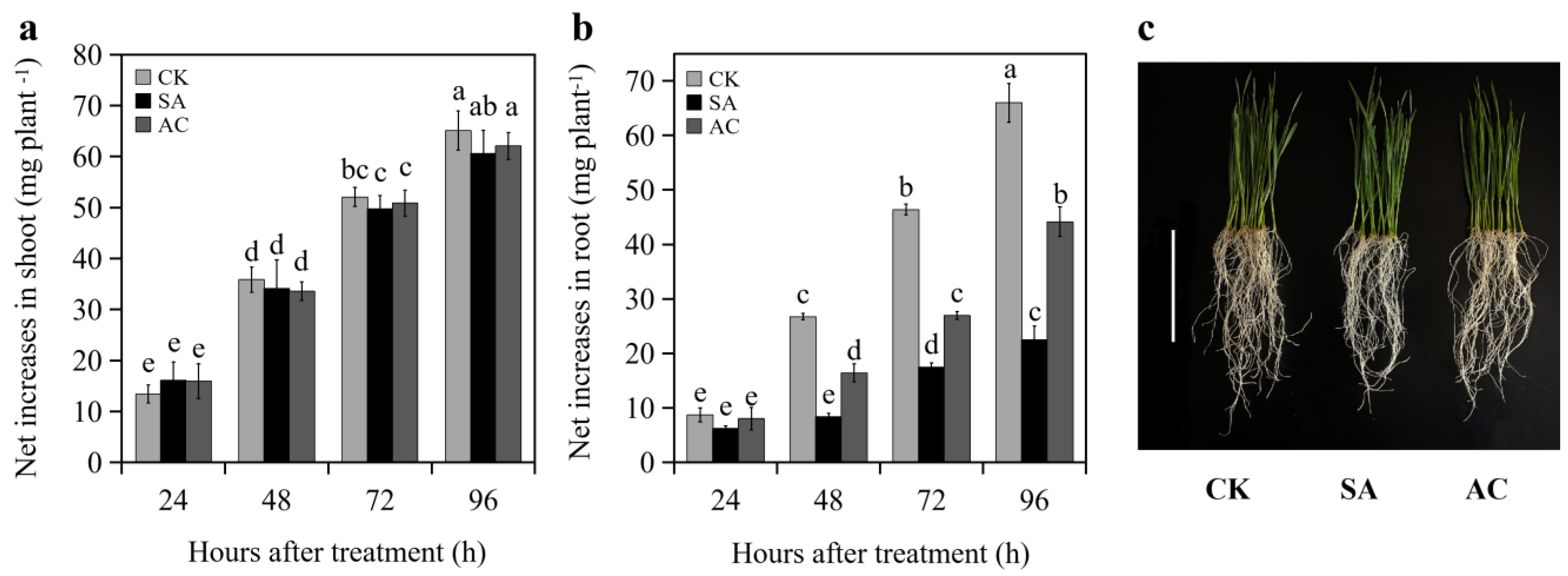
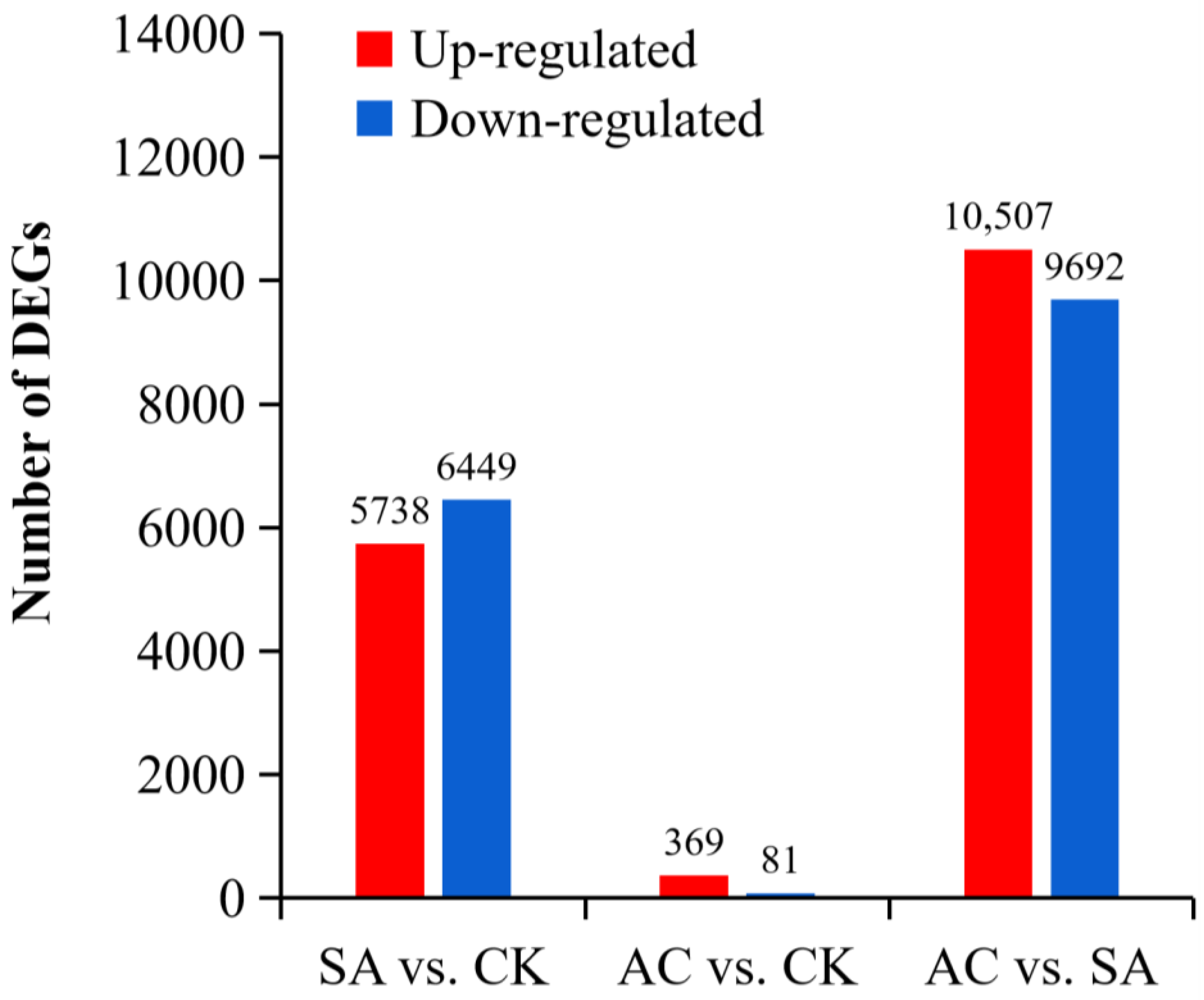
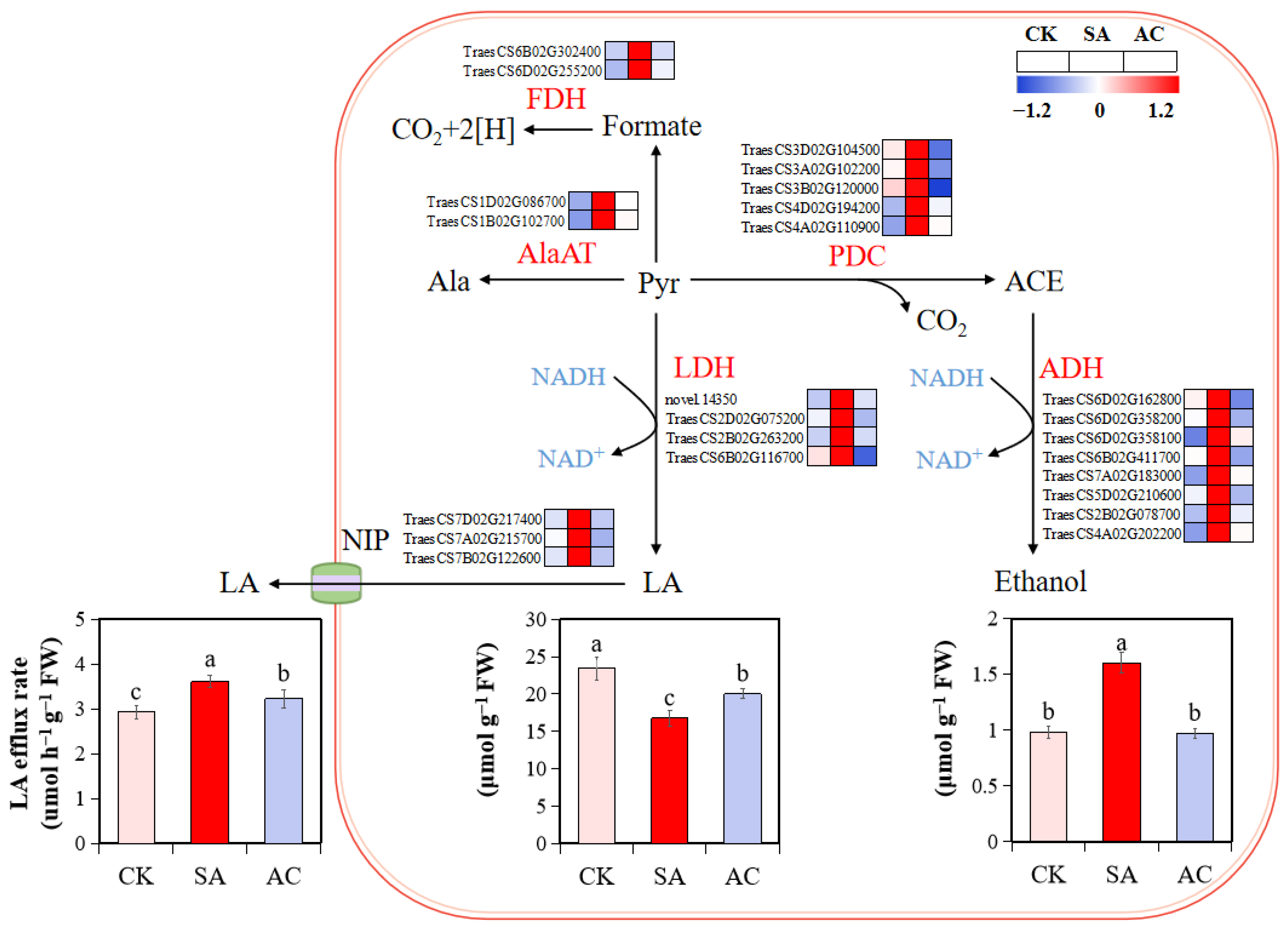
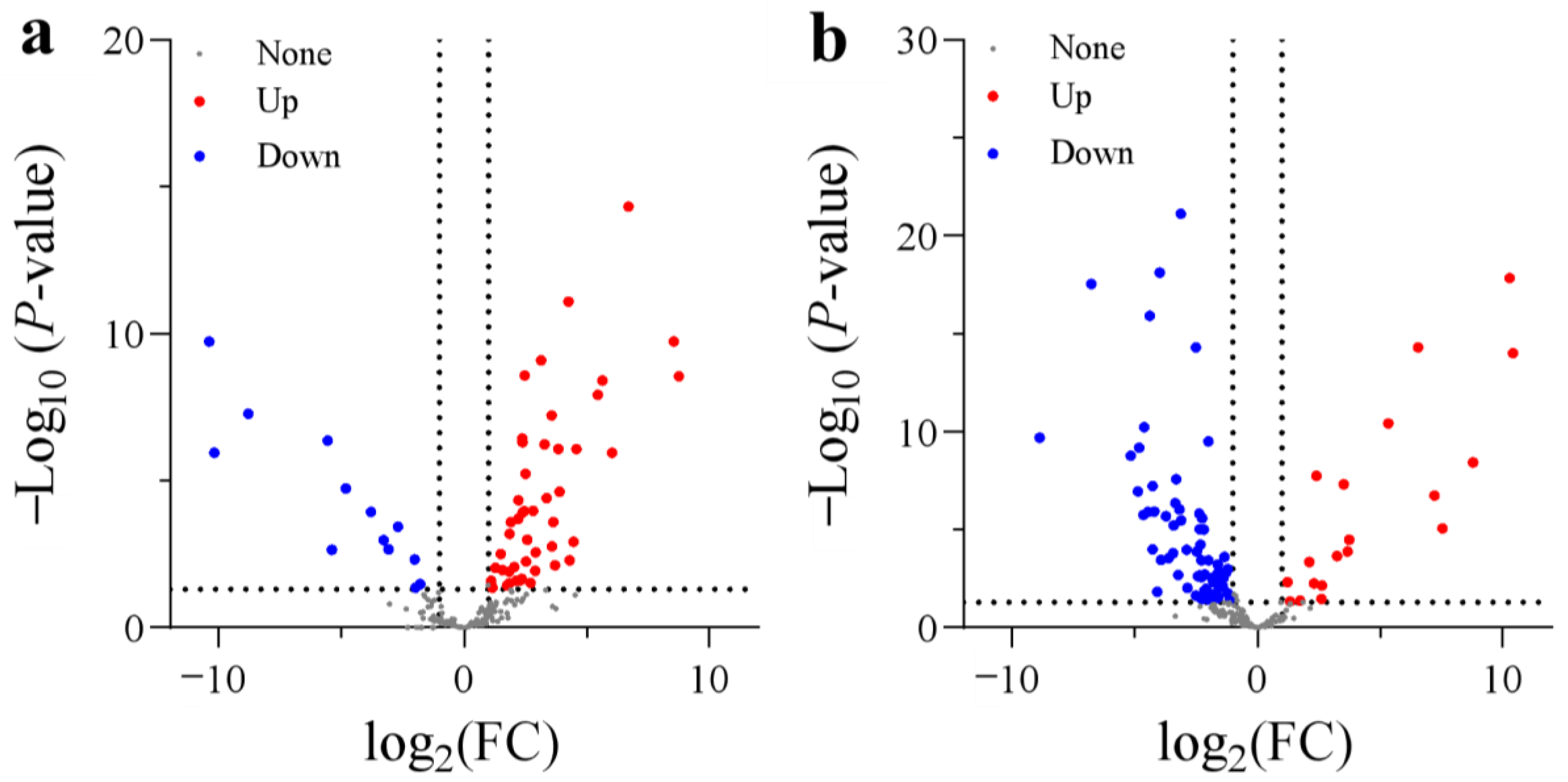
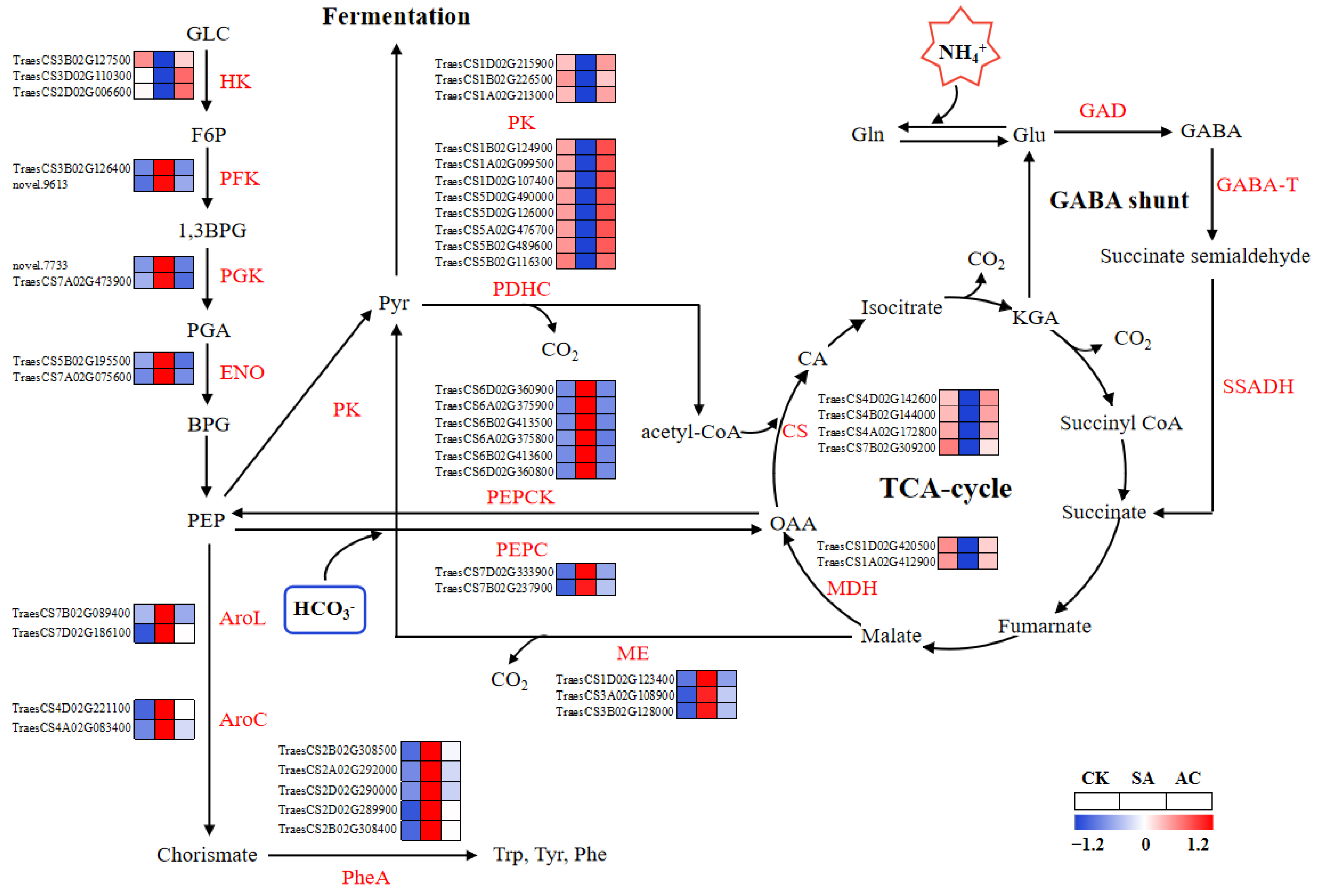
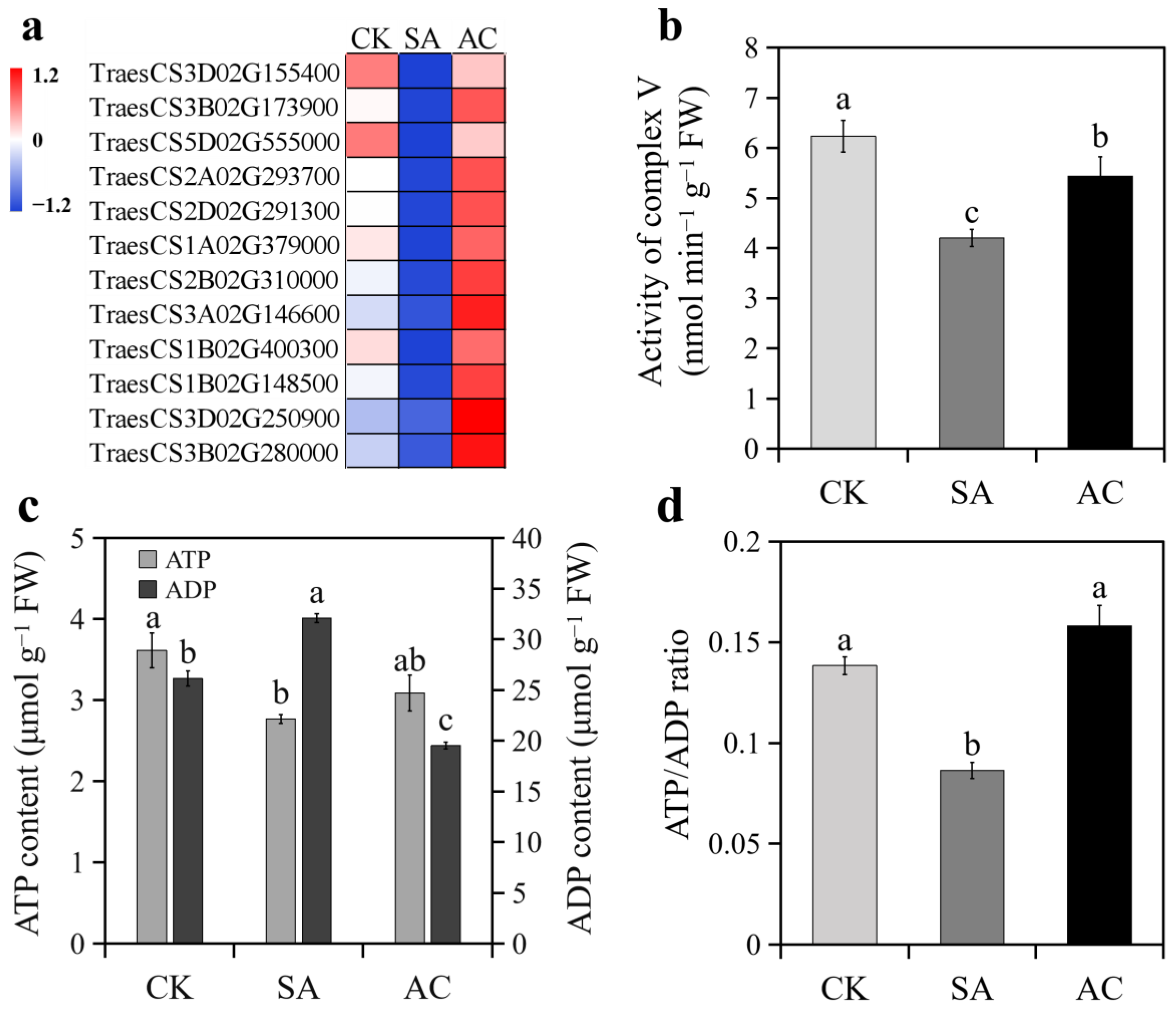
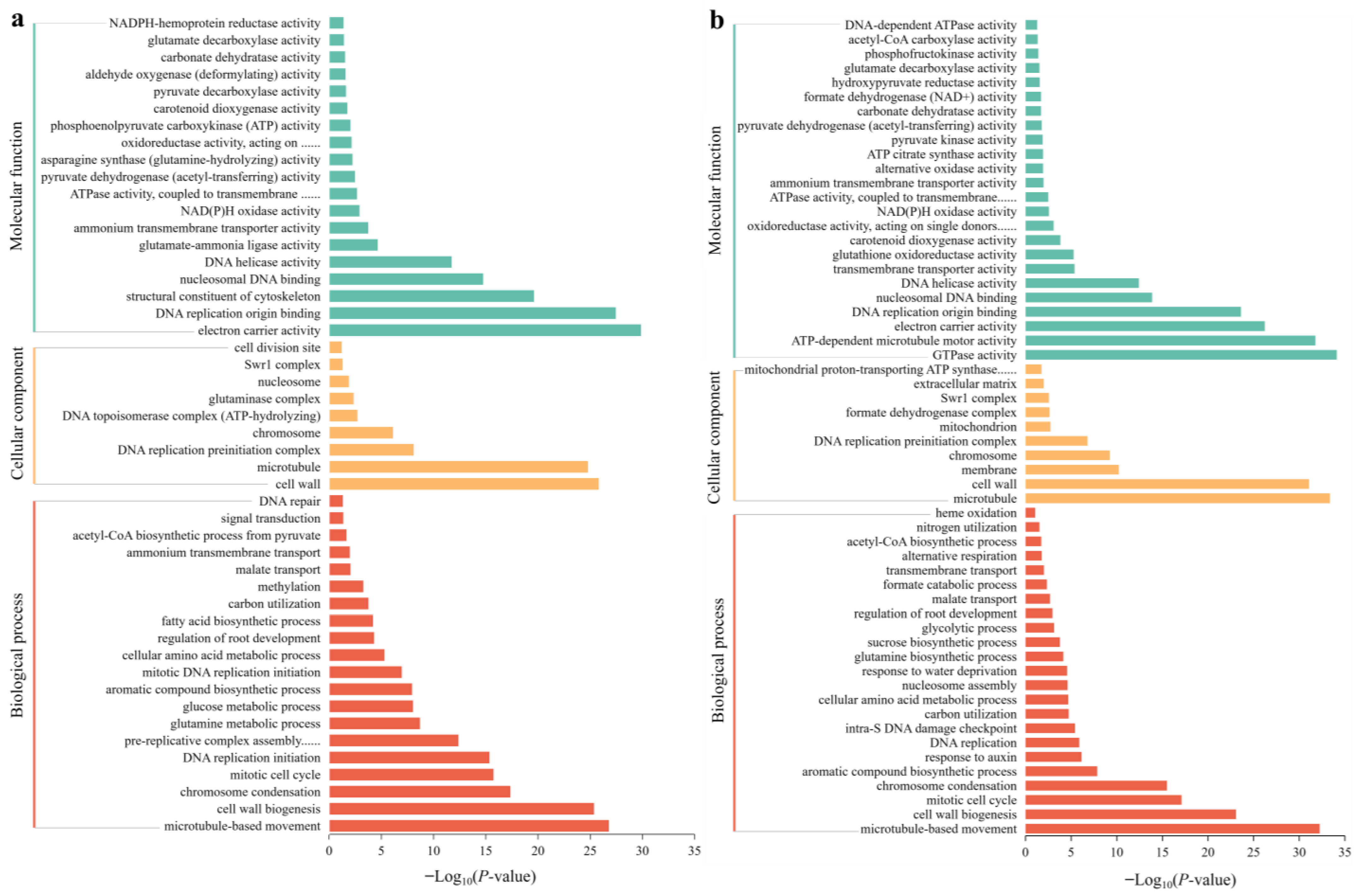
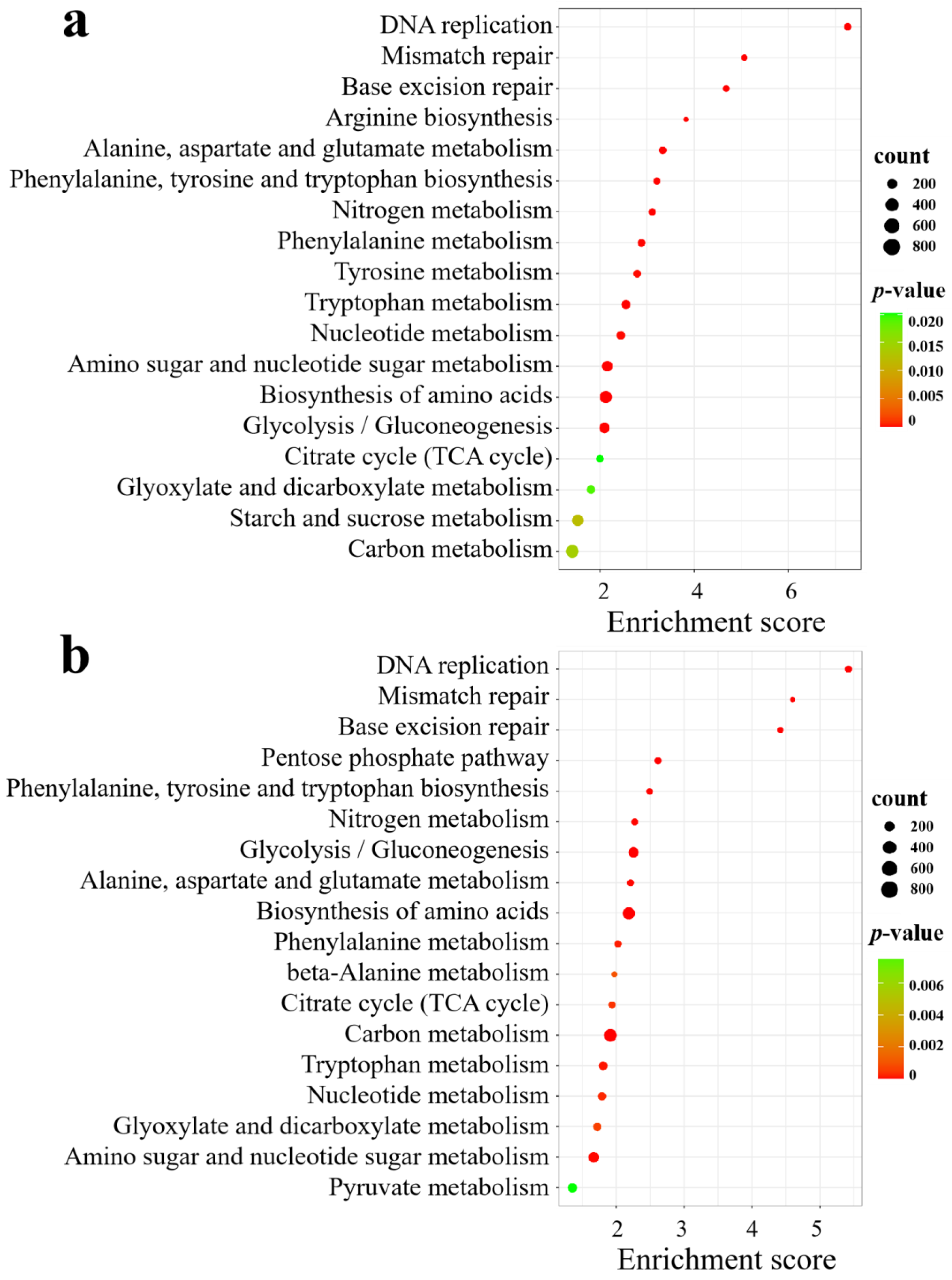
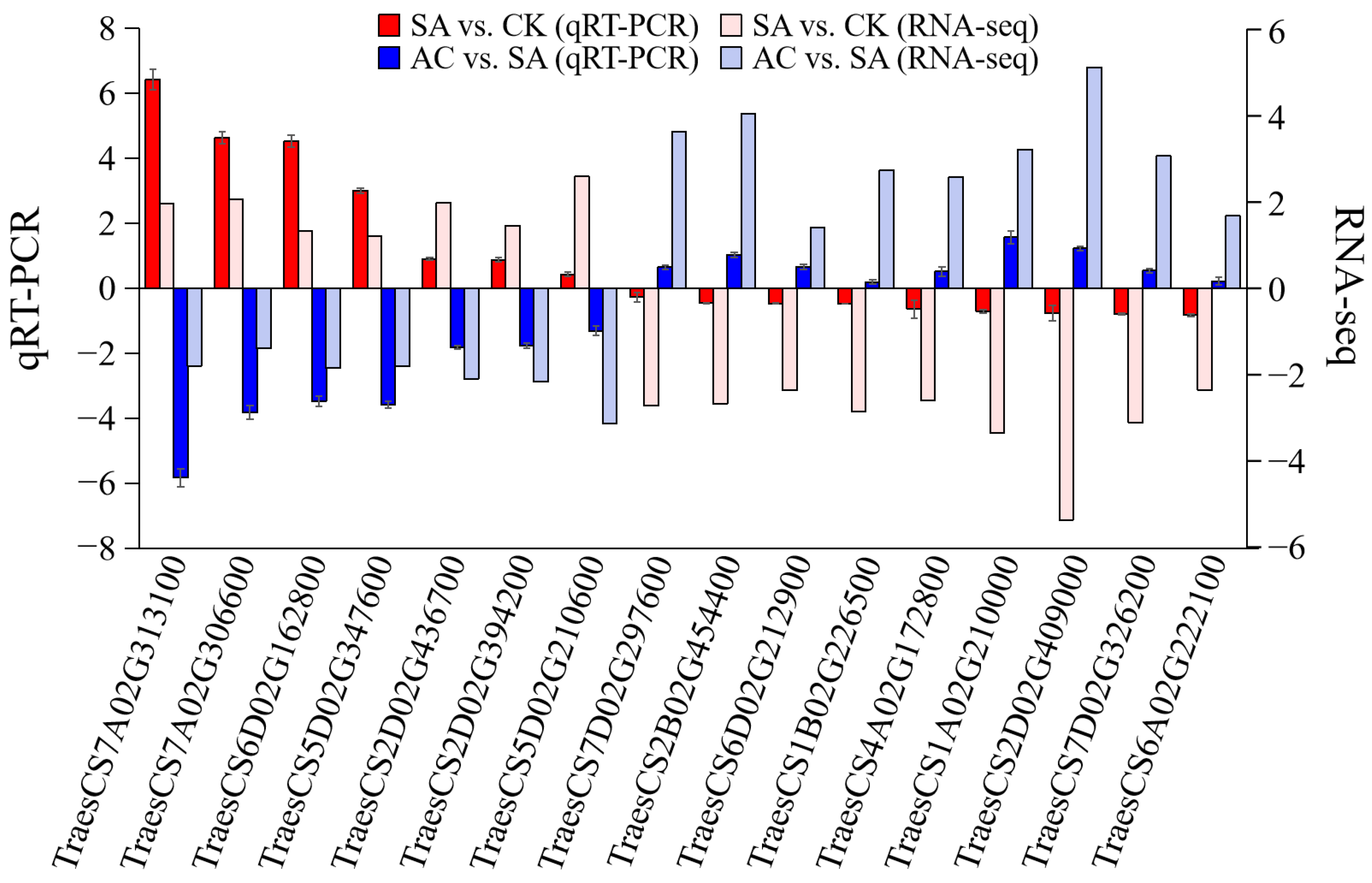
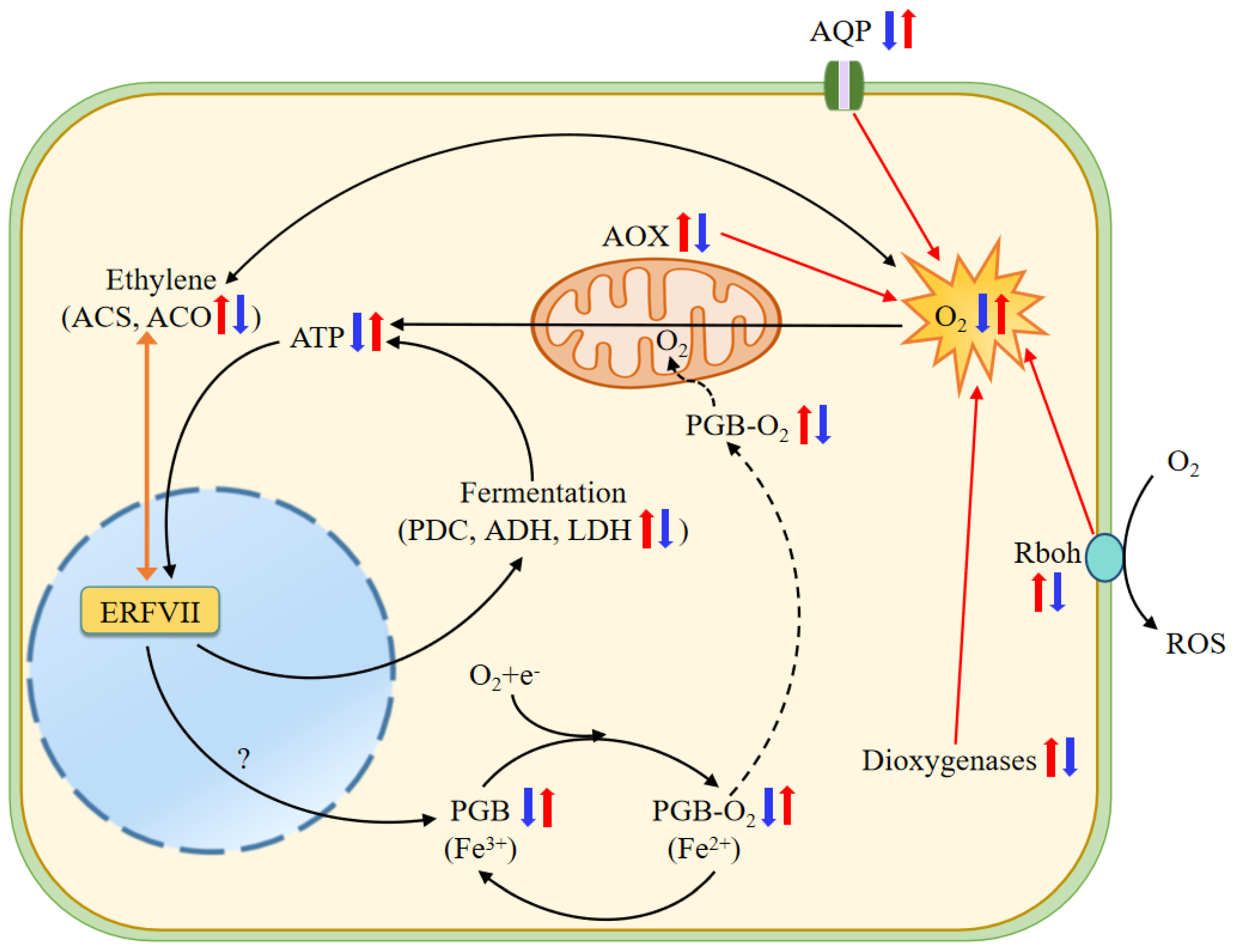
| Gene ID | Gene Expression | Gene Description | Species | References | ||
|---|---|---|---|---|---|---|
| Hypoxia-induced proteins and regulators of hypoxia-inducible factor (HIF) pathway | ||||||
| TraesCS2D02G438000 | Hypoxia-induced protein conserved region | Mammalia | [40] | |||
| TraesCS1B02G316600 | Probable prolyl 4-hydroxylase 4 | Mammalia | [41] | |||
| TraesCS6B02G456400 | Probable prolyl 4-hydroxylase 3 | Mammalia | [42] | |||
| Burst oxidase homologs | ||||||
| TraesCS4D02G324800 | Respiratory burst oxidase homolog protein C | Zea mays | [43] | |||
| TraesCS5D02G306400 | Respiratory burst oxidase homolog protein C | Nicotiana tabacum | [44] | |||
| TraesCS5D02G105900 | Respiratory burst oxidase homolog protein B | |||||
| TraesCS5A02G301700 | Respiratory burst oxidase homolog protein C | |||||
| TraesCS4B02G327800 | Respiratory burst oxidase homolog protein C | |||||
| Alternative electron transport pathways | ||||||
| TraesCS3D02G343900 | Internal alternative NADH dehydrogenase NDA1 | Zea mays | [45] | |||
| TraesCS7A02G306600 | External alternative NADH dehydrogenase NDB2 | |||||
| TraesCS7D02G303500 | External alternative NADH dehydrogenase NDB2 | |||||
| TraesCS7B02G206900 | External alternative NADH dehydrogenase NDB2 | |||||
| TraesCS2A02G439400 | Alternative oxidase 1a, mitochondrial | Nicotiana tabacum | [46] | |||
| TraesCS2D02G436700 | Alternative oxidase 1a, mitochondrial | Nicotiana tabacum | [44] | |||
| TraesCS2A02G438200 | Alternative oxidase 1b, mitochondrial | |||||
| TraesCS2B02G459300 | Alternative oxidase 1a, mitochondrial | |||||
| Aquaporin | ||||||
| TraesCS5D02G561700 | Aquaporin PIP2-2 | Glycine max | [47] | |||
| TraesCS7B02G002000 | Probable aquaporin PIP2-1 | Sorghum bicolor | [48] | |||
| TraesCS5B02G570800 | Aquaporin PIP2-2 | |||||
| TraesCS2B02G425600 | Aquaporin PIP1-3/PIP1-4 | |||||
| TraesCS6D02G212900 | Probable aquaporin PIP2-2 | |||||
| TraesCS6A02G222100 | Probable aquaporin PIP2-2 | |||||
| TraesCS2D02G404800 | Aquaporin PIP1-3/PIP1-4 | |||||
| TraesCS2A02G407700 | Aquaporin PIP1-3/PIP1-4 | |||||
| TraesCS2A02G065700 | Probable aquaporin PIP2-6 | |||||
| TraesCS6B02G259000 | Probable aquaporin PIP2-2 | |||||
| TraesCS6A02G405600 | Aquaporin PIP1-5 | |||||
| TraesCS2B02G077700 | Probable aquaporin PIP2-6 | |||||
| TraesCS2D02G063900 | Probable aquaporin PIP2-6 | |||||
| TraesCS5A02G181000 | Aquaporin PIP1-5 | |||||
| N metabolism and GABA shunt | ||||||
| TraesCS4B02G053600 | Glutamate decarboxylase 1 | Arabidopsis thaliana | [49] | |||
| TraesCS4A02G261000 | Glutamate decarboxylase 1 | Cucumis sativus | [50] | |||
| TraesCS4D02G053600 | Glutamate decarboxylase 1 | |||||
| TraesCS1A02G374600 | Glutamate decarboxylase | |||||
| TraesCS2D02G303600 | Aspartate aminotransferase | Cucumis sativus | [50] | |||
| TraesCS2D02G451900 | Aspartate aminotransferase, mitochondrial | |||||
| TraesCS2A02G452100 | Glutamate/aspartate-prephenate aminotransferase | |||||
| TraesCS3B02G047500 | Aspartate aminotransferase | |||||
| TraesCS2A02G188100 | Glutamate/aspartate-prephenate aminotransferase | |||||
| TraesCS2B02G219100 | Alanine aminotransferase 2 | Medicago truncatula | [51] | |||
| TraesCS5A02G336500 | Alanine aminotransferase 2 | Lotus japonicus | [52] | |||
| TraesCS7D02G326200 | Gamma-aminobutyrate transaminase 1, mitochondrial | Oryza sativa | [53] | |||
| TraesCS7A02G323200 | Probable gamma-aminobutyrate transaminase 4 | |||||
| TraesCS5B02G335500 | Succinate-semialdehyde dehydrogenase, mitochondrial | Arabidopsis thaliana | [54] | |||
| TraesCS5D02G341200 | Succinate-semialdehyde dehydrogenase, mitochondrial | |||||
| TraesCS7A02G329300 | Succinate-semialdehyde dehydrogenase, mitochondrial | |||||
| O2-binding and Fe transport | ||||||
| TraesCS1B02G350800 | Non-symbiotic hemoglobin | Oryza sativa | [55] | |||
| TraesCS1A02G338400 | Non-symbiotic hemoglobin 1 | |||||
| TraesCS6D02G148200 | Nicotianamine synthase 1 | Citrus junos | [56] | |||
| TraesCS6A02G163200 | Nicotianamine synthase 1 | |||||
| TraesCS3B02G479500 | 2′-Deoxymugineic-acid 2′-dioxygenase | Mammalia | [42] | |||
| TraesCS3D02G437500 | 2′-Deoxymugineic-acid 2′-dioxygenase | |||||
| TraesCS3A02G445000 | 2′-Deoxymugineic-acid 2′-dioxygenase | |||||
| TraesCS4A02G294300 | Fe(2+) transport protein 1 | |||||
| TraesCS4B02G019300 | Fe(2+) transport protein 1 | |||||
| DNA and chromatin metabolic processes | ||||||
| TraesCS4B02G053600 | ATP-dependent DNA helicase DDM1 | Arabidopsis thaliana | [57] | |||
| TraesCS4A02G261000 | ATP-dependent DNA helicase DDM1 | |||||
| TraesCS4D02G053600 | ATP-dependent DNA helicase DDM1 | |||||
| TraesCS1A02G374600 | Increased DNA methylation 1 | |||||
| TraesCS2D02G303600 | Protein RNA-directed DNA methylation 12 | |||||
| TraesCS2D02G451900 | Protein RNA-directed DNA methylation 12 | |||||
| TraesCS2A02G452100 | ATP-dependent DNA helicase DDM1 | |||||
| TraesCS3B02G047500 | RuvB-like protein 1 | |||||
| TraesCS2A02G188100 | RuvB-like 2 | |||||
| TraesCS2B02G219100 | RuvB-like 2 | |||||
| TraesCS5A02G336500 | Chromatin assembly factor 1 subunit FSM | Arabidopsis thaliana | [58] | |||
| TraesCS7D02G326200 | Nucleosome/chromatin assembly factor group D 07 | |||||
| TraesCS7A02G323200 | Chromatin assembly factor 1 subunit FAS2 homolog | |||||
| TraesCS5B02G335500 | Chromatin assembly factor 1 subunit FSM | |||||
| TraesCS5D02G341200 | Chromatin assembly factor 1 subunit FSM | |||||
| TraesCS7A02G329300 | Nucleosome/chromatin assembly factor group D 07 | |||||
| TraesCS7D02G319800 | Chromatin assembly factor 1 subunit FAS2 homolog | |||||
| TraesCS7B02G230000 | Nucleosome/chromatin assembly factor group D 07 | |||||
| TraesCS2B02G466000 | Nucleosome/chromatin assembly factor group D 06 | |||||
| TraesCS2A02G445000 | Nucleosome/chromatin assembly factor group D 06 | |||||
| TraesCS5B02G332200 | Histone-binding protein MSI1 homolog | |||||
| TraesCS7B02G224100 | Chromatin assembly factor 1 subunit FAS2 homolog | |||||
| TraesCS5A02G331900 | Histone-binding protein MSI1 homolog | |||||
| TraesCS5B02G403900 | Protein TRI1 | |||||
| TraesCS5D02G408400 | Protein TRI1 | |||||
| novel.8650 | Replication Fork Protection Component Swi3 | |||||
| novel.10308 | Replication Fork Protection Component Swi3 | |||||
| TraesCS2A02G072700 | SWI/SNF-related matrix-associated actin-dependent regulator | Mammalia | [59] | |||
| TraesCS3D02G068900 | Probable chromatin-remodeling complex ATPase chain | |||||
| TraesCS3B02G083400 | Probable chromatin-remodeling complex ATPase chain | |||||
| TraesCS3A02G069900 | Probable chromatin-remodeling complex ATPase chain | |||||
| Ethylene signaling | ||||||
| TraesCS2A02G026800 | 1-Aminocyclopropane-1-carboxylate oxidase homolog 2 | Cucumis sativus | [50] | |||
| TraesCS5D02G241100 | 1-Aminocyclopropane-1-carboxylate oxidase 1 | Nicotiana tabacum | [44] | |||
| TraesCS2B02G040100 | 1-Aminocyclopropane-1-carboxylate oxidase homolog 1 | |||||
| TraesCS6A02G325700 | 1-Aminocyclopropane-1-carboxylate oxidase 3 | |||||
| TraesCS2A02G026500 | 1-Aminocyclopropane-1-carboxylate oxidase homolog 1 | |||||
| TraesCS1B02G117500 | 1-Aminocyclopropane-1-carboxylate oxidase | |||||
| TraesCS1A02G089600 | 1-Aminocyclopropane-1-carboxylate oxidase | |||||
| TraesCS1A02G089500 | 1-Aminocyclopropane-1-carboxylate oxidase | |||||
| TraesCS7D02G536900 | 1-Aminocyclopropane-1-carboxylate oxidase homolog 2 | |||||
| TraesCS1B02G117400 | 1-Aminocyclopropane-1-carboxylate oxidase | |||||
| TraesCS2D02G394200 | 1-Aminocyclopropane-1-carboxylate synthase | |||||
| TraesCS7D02G127600 | Ethylene-responsive transcription factor RAP2-9 | Arabidopsis thaliana | [60] | |||
| TraesCS2B02G127800 | Ethylene-responsive transcription factor RAP2-3 | |||||
| Carriers for transport of substrates and S-type anion channel | ||||||
| TraesCS5A02G300800 | Mitochondrial dicarboxylate carrier 1 | Arabidopsis thaliana | [61] | |||
| TraesCS5D02G307000 | Mitochondrial dicarboxylate carrier 1 | |||||
| TraesCS5B02G300300 | Mitochondrial dicarboxylate carrier 1 | |||||
| TraesCS3D02G157800 | Mitochondrial arginine transporter BAC2 | Oryza sativa | [62] | |||
| TraesCS3B02G177000 | Mitochondrial arginine transporter BAC2 | |||||
| TraesCS3A02G225100 | S-type anion channel SLAH3 | Arabidopsis thaliana | [63] | |||
| TraesCS3B02G254700 | S-type anion channel SLAH3 | |||||
| TraesCSU02G001600 | S-type anion channel SLAH2 | |||||
| Allene oxide synthase (alpha-Linolenic acid metabolism) | ||||||
| TraesCS4B02G237600 | Allene oxide synthase 2 | Arabidopsis thaliana | [64] | |||
| Nudix hydrolase | ||||||
| novel.15168 | Nudix hydrolase 17 | Mammalian | [65] | |||
| TraesCS6B02G326200 | Nudix hydrolase 17 | Mammalian | [40] | |||
| TraesCS7B02G110900 | Nudix hydrolase 21 | |||||
| Activity (nmol min−1 g−1 FW) | CK | SA | AC | Change (SA vs. CK) (%) | Change (AC vs. SA) (%) |
|---|---|---|---|---|---|
| PDC | 72.11 ± 1.17 b | 98.57 ± 1.74 a | 79.16 ± 3.25 b | 36.69 ± 2.42 | −19.69 ± 3.31 |
| ADH | 26.53 ± 1.96 c | 38.12 ± 1.04 a | 32.96 ± 1.99 b | 43.66 ± 3.94 | −13.52 ± 5.22 |
| LDH | 57.67 ± 5.04 b | 93.20 ± 5.94 a | 62.84 ± 5.40 ab | 61.90 ± 6.97 | −32.35 ± 7.66 |
| PK | 1172.05 ± 14.85 a | 1039.71 ± 23.17 c | 1085.18 ± 14.49 b | −11.29 ± 1.98 | 4.37 ± 1.39 |
| PDH | 1.72 ± 0.09 b | 1.53 ± 0.08 b | 2.95 ± 0.17 a | −11.15 ± 4.91 | 93.17 ± 11.27 |
| Concentration (µg g−1 FW) | CK | SA | AC |
|---|---|---|---|
| Ala | 635.78 ± 2.92 c | 763.37 ± 7.12 a | 736.99 ± 1.46 b |
| formate | 150.83 ± 1.14 b | 240.93 ± 13.99 a | 246.21 ± 7.84 a |
| Trp | 10.73 ± 0.16 c | 18.39 ± 0.04 a | 13.32 ± 0.05 b |
| Tyr | 42.90 ± 0.94 c | 68.93 ± 0.01 a | 60.63 ± 1.94 b |
| Phe | 58.72 ± 0.25 c | 79.61 ± 0.13 a | 75.96 ± 0.86 b |
| Pyr | 98.80 ± 0.03 a | 70.12 ± 0.03 c | 85.67 ± 0.30 b |
| acetyl-CoA | 47.34 ± 2.25 a | 36.25 ± 2.00 c | 42.54 ± 1.69 b |
| CA | 101.02 ± 9.28 a | 51.16 ± 4.74 b | 56.36 ± 0.84 b |
| KGA | 6.99 ± 0.05 a | 4.59 ± 0.23 c | 5.98 ± 0.19 b |
| succinate | 2322.80 ± 51.37 a | 1173.72 ± 8.72 c | 1928.36 ± 90.09 b |
| fumarate | 196.15 ± 6.03 b | 80.45 ± 0.66 c | 221.67 ± 6.57 a |
| malate | 882.76 ± 39.05 a | 327.22 ± 15.67 c | 683.86 ± 5.87 b |
| OAA | 11.60 ± 0.03 a | 1.79 ± 0.02 c | 3.20 ± 0.30 b |
| GABA | 311.16 ± 2.14 b | 444.51 ± 0.71 a | 279.76 ± 0.78 c |
| Gene ID | Gene Expression | Gene Description | ||
|---|---|---|---|---|
| Mitotic-specific cyclin and mitotic checkpoint proteins | ||||
| TraesCS4D02G076900 | G2/mitotic-specific cyclin-A3-1 | |||
| TraesCS1B02G320900 | G2/mitotic-specific cyclin-B1-5 | |||
| TraesCS1A02G309800 | G2/mitotic-specific cyclin-B1-5 | |||
| TraesCS1D02G309300 | G2/mitotic-specific cyclin-B1-5 | |||
| TraesCS3A02G157000 | G2/mitotic-specific cyclin-A1-1 | |||
| TraesCS5D02G121100 | G2/mitotic-specific cyclin-A2-1 | |||
| TraesCS7A02G549500 | G2/mitotic-specific cyclin-B2-2 | |||
| TraesCS1B02G321000 | G2/mitotic-specific cyclin-B1-5 | |||
| TraesCS3D02G326600 | G2/mitotic-specific cyclin-B1-1 | |||
| TraesCS7D02G536000 | G2/mitotic-specific cyclin-B2-2 | |||
| TraesCS6B02G195800 | Mitotic spindle checkpoint protein BUBR1 | |||
| TraesCS6A02G168100 | Mitotic spindle checkpoint protein BUBR1 | |||
| TraesCS3B02G183400 | G2/mitotic-specific cyclin-A1-1 | |||
| TraesCS7B02G472800 | G2/mitotic-specific cyclin-B2-2 | |||
| TraesCS4B02G078300 | G2/mitotic-specific cyclin-A3-1 | |||
| TraesCS5B02G078200 | G2/mitotic-specific cyclin-A3-2 | |||
| novel.19039 | G2/mitotic-specific cyclin-A2-1 | |||
| TraesCS1D02G309400 | G2/mitotic-specific cyclin-B1-5 | |||
| TraesCS4A02G236700 | G2/mitotic-specific cyclin-A3-1 | |||
| TraesCS5A02G108500 | G2/mitotic-specific cyclin-A2-1 | |||
| TraesCS3B02G363200 | G2/mitotic-specific cyclin-B1-1 | |||
| TraesCS3D02G164600 | G2/mitotic-specific cyclin-A1-1 | |||
| TraesCS3A02G333000 | G2/mitotic-specific cyclin-B1-1 | |||
| TraesCS5B02G493100 | Condensin-2 complex subunit D3 | |||
| TraesCS5B02G114300 | G2/mitotic-specific cyclin-A2-1 | |||
| TraesCS3A02G523600 | G2/mitotic-specific cyclin-A2-1 | |||
| TraesCS2A02G404800 | G2/mitotic-specific cyclin-B2-1 | |||
| novel.314 | G2/mitotic-specific cyclin-B1-5 | |||
| TraesCS6D02G157200 | Mitotic spindle checkpoint protein BUBR1 | |||
| TraesCS2D02G401700 | G2/mitotic-specific cyclin-B2-1 | |||
| TraesCS5D02G493500 | Condensin-2 complex subunit D3 | |||
| TraesCS2B02G422800 | G2/mitotic-specific cyclin-B2-1 | |||
| TraesCS5A02G480000 | Condensin-2 complex subunit D3 | |||
| TraesCS5B02G401600 | Mitotic checkpoint protein BUB3.3 | |||
| TraesCS5A02G072000 | G2/mitotic-specific cyclin-A3-2 | |||
| TraesCS2A02G320000 | Mitotic spindle checkpoint protein MAD2 | |||
| TraesCSU02G054300 | G2/mitotic-specific cyclin-A2-1 | |||
| TraesCS2B02G249400 | Mitotic checkpoint serine/threonine-protein kinase BUB1 | |||
| TraesCS2A02G226000 | Mitotic checkpoint serine/threonine-protein kinase BUB1 | |||
| TraesCS5A02G396600 | Mitotic checkpoint protein BUB3.3 | |||
| Cell division | ||||
| TraesCS3D02G123900 | Cell division cycle 20.1, cofactor of APC complex | |||
| TraesCS3B02G141100 | Cell division cycle-associated 7-like protein | |||
| TraesCS6A02G268900 | Cell division cycle-associated 7-like protein | |||
| TraesCS1D02G219200 | Cell division control protein 45 homolog | |||
| TraesCS7D02G198900 | Cell division control protein 6 homolog | |||
| TraesCS2A02G488400 | Cell division cycle-associated 7-like protein | |||
| TraesCS6B02G296200 | Cell division protein FtsZ homolog 1 | |||
| TraesCS7B02G102800 | Cell division cycle-associated 7-like protein | |||
| TraesCS7A02G197400 | Cell division control protein 45 homolog | |||
| TraesCS3A02G121700 | Cell division cycle 7-related protein kinase | |||
| TraesCS6D02G246000 | Cell division cycle-associated 7-like protein | |||
| TraesCS2B02G516000 | Cell division control protein 45 homolog | |||
| TraesCS5D02G149500 | Cell division cycle-associated 7-like protein | |||
| TraesCS5B02G141300 | Cell division control protein 6 homolog | |||
| TraesCS3D02G080400 | Cell division control protein 45 homolog | |||
| TraesCS1B02G230600 | Cell division cycle-associated 7-like protein | |||
| TraesCS3A02G080700 | Cell division cycle 20.1, cofactor of APC complex | |||
| TraesCS4D02G123200 | Cell division cycle-associated 7-like protein | |||
| TraesCS3A02G369000 | Cell division cycle 20.1, cofactor of APC complex | |||
| TraesCS3B02G095100 | Cell division cycle protein 27 homolog B | |||
| TraesCS4B02G129200 | Cell division cycle-associated 7-like protein | |||
| TraesCS4B02G230900 | Cell division cycle protein 16 homolog | |||
| TraesCS6A02G251400 | Cell division control protein 45 homolog | |||
| TraesCS7D02G392900 | Cell division cycle 7-related protein kinase | |||
| TraesCS5A02G142600 | Cell division protein FtsZ homolog 1, chloroplastic | |||
| TraesCS3B02G400900 | Cell division cycle protein 23 homolog | |||
| Cell elongation | ||||
| TraesCS5A02G250600 | Protein activator for cell elongation 1 | |||
| TraesCS7B02G118800 | Protein activator for cell elongation 1 | |||
| TraesCS4A02G060200 | Protein activator for cell elongation 2 | |||
| TraesCS7A02G559400 | Cell elongation protein Dwarf1 | |||
| TraesCS7B02G484200 | Cell elongation protein Dwarf1 | |||
| TraesCS5D02G258300 | Protein activator for cell elongation 1 | |||
Disclaimer/Publisher’s Note: The statements, opinions and data contained in all publications are solely those of the individual author(s) and contributor(s) and not of MDPI and/or the editor(s). MDPI and/or the editor(s) disclaim responsibility for any injury to people or property resulting from any ideas, methods, instructions or products referred to in the content. |
© 2024 by the authors. Licensee MDPI, Basel, Switzerland. This article is an open access article distributed under the terms and conditions of the Creative Commons Attribution (CC BY) license (https://creativecommons.org/licenses/by/4.0/).
Share and Cite
Liu, X.; Zhang, Y.; Tang, C.; Li, H.; Xia, H.; Fan, S.; Kong, L. Bicarbonate-Dependent Detoxification by Mitigating Ammonium-Induced Hypoxic Stress in Triticum aestivum Root. Biology 2024, 13, 101. https://doi.org/10.3390/biology13020101
Liu X, Zhang Y, Tang C, Li H, Xia H, Fan S, Kong L. Bicarbonate-Dependent Detoxification by Mitigating Ammonium-Induced Hypoxic Stress in Triticum aestivum Root. Biology. 2024; 13(2):101. https://doi.org/10.3390/biology13020101
Chicago/Turabian StyleLiu, Xiao, Yunxiu Zhang, Chengming Tang, Huawei Li, Haiyong Xia, Shoujin Fan, and Lingan Kong. 2024. "Bicarbonate-Dependent Detoxification by Mitigating Ammonium-Induced Hypoxic Stress in Triticum aestivum Root" Biology 13, no. 2: 101. https://doi.org/10.3390/biology13020101
APA StyleLiu, X., Zhang, Y., Tang, C., Li, H., Xia, H., Fan, S., & Kong, L. (2024). Bicarbonate-Dependent Detoxification by Mitigating Ammonium-Induced Hypoxic Stress in Triticum aestivum Root. Biology, 13(2), 101. https://doi.org/10.3390/biology13020101









